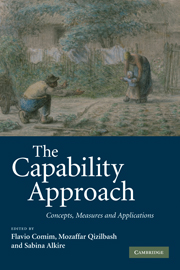Book contents
- Frontmatter
- Contents
- List of figures
- List of tables
- List of contributors
- List of acronyms
- Acknowledgements
- Introduction
- 1 Using the capability approach: prospective and evaluative analyses
- PART I Concepts
- PART II Measures
- PART III Applications
- 12 Democracy, decentralisation and access to basic services: an elaboration on Sen's capability approach
- 13 Reinforcing households' capabilities as a way to reduce vulnerability and prevent poverty in equitable terms
- 14 Capabilities over the lifecourse: at what age does poverty damage most?
- 15 Social policy and the ability to appear in public without shame: Some lessons from a food relief programme in Kinshasa
- 16 The capability approach and gendered education: some issues of operationalisation in the context of the HIV/AIDs epidemic in South Africa
- 17 Women and poverty in Mozambique: is there a gender bias in capabilities, employment conditions and living standards?
- 18 From the quantity to the quality of employment: an application of the capability approach to the Chilean labour market
- Index
- References
18 - From the quantity to the quality of employment: an application of the capability approach to the Chilean labour market
Published online by Cambridge University Press: 22 September 2009
- Frontmatter
- Contents
- List of figures
- List of tables
- List of contributors
- List of acronyms
- Acknowledgements
- Introduction
- 1 Using the capability approach: prospective and evaluative analyses
- PART I Concepts
- PART II Measures
- PART III Applications
- 12 Democracy, decentralisation and access to basic services: an elaboration on Sen's capability approach
- 13 Reinforcing households' capabilities as a way to reduce vulnerability and prevent poverty in equitable terms
- 14 Capabilities over the lifecourse: at what age does poverty damage most?
- 15 Social policy and the ability to appear in public without shame: Some lessons from a food relief programme in Kinshasa
- 16 The capability approach and gendered education: some issues of operationalisation in the context of the HIV/AIDs epidemic in South Africa
- 17 Women and poverty in Mozambique: is there a gender bias in capabilities, employment conditions and living standards?
- 18 From the quantity to the quality of employment: an application of the capability approach to the Chilean labour market
- Index
- References
Summary
Introduction
Analysing a labour market based on the development of its unemployment rate is as simplistic as assessing a country's level of development based solely on its GDP per capita figures. Yet this is precisely what most labour market analysts do.
This chapter will show how an application of Amartya Sen's capability approach to the Chilean labour market breaks up such a perspective by obliging us to take into account a series of other variables related to the quality of employment that are at least as important to individual wellbeing as having a job in the first place.
Employment is a subject very much neglected by the development literature, even though it is the central factor in an individual's wellbeing once his or her most basic needs have been covered. The capability approach therefore has much to contribute to any debate on the labour markets of developing countries. This chapter uses the results of a survey specifically designed and implemented by the author to create an indicator of the quality of employment, and will demonstrate the uses of such an indicator in order to show how the capability approach can be used as a policy making tool to capture the capabilities and functionings associated with employment far better than other measures such as an unemployment rate.
This chapter also applies the capability approach to a country with a higher level of development than most of the examples that have been used so far to illustrate the approach.
- Type
- Chapter
- Information
- The Capability ApproachConcepts, Measures and Applications, pp. 561 - 596Publisher: Cambridge University PressPrint publication year: 2008
References
- 6
- Cited by



